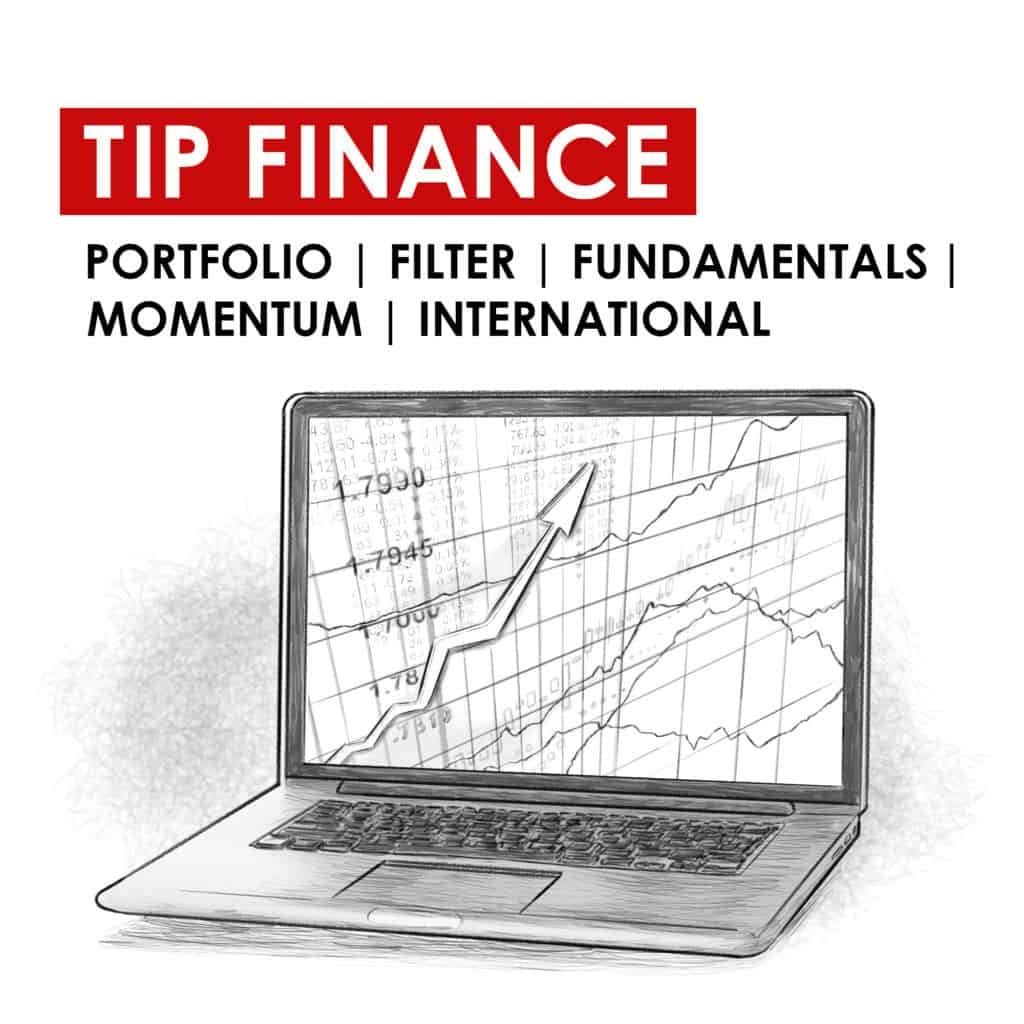Emergency Measures
29 August 2022

Hi, The Investor’s Podcast Network Community!
Welcome back to We Study Markets!
After a devastating selloff in the S&P 500 and Nasdaq on Friday following Fed Chair Powell’s speech, many have been quick to pronounce the summer rally dead, especially after another round of sharp declines today.
What we’re wondering is how summer flew by so fast — September begins in just a few days. Seriously, where does the time go?
On the other side of the pond, oil and gas giant, Shell, saw its chief executive warn that Europe may have to ration energy use for years as flows of Russian gas slow.
In the U.S., fewer Americans are living paycheck to paycheck with estimates declining from 61% of the population in June to 59% in July, yet this is still higher than 54% from a year ago.
Here’s the market rundown:
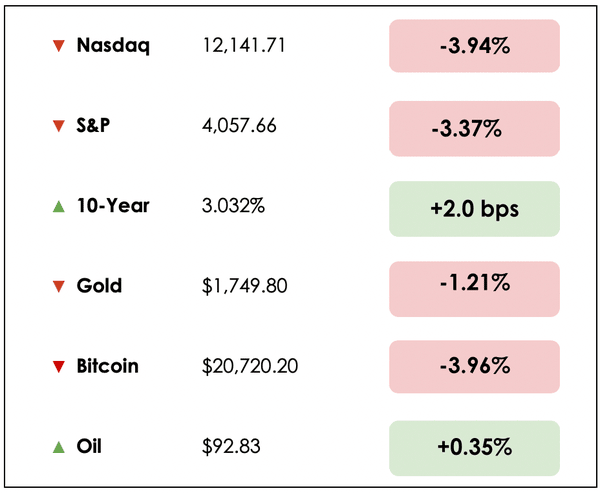
*All prices as of market close at 4pm EST
Today, we’ll discuss emergency measures in Europe to curb energy prices, record-breaking baseball cards, the surge in two-year bonds, and AQR Capital’s outlook for the rest of the year.
All this, and more, in just 5 minutes to read.
Let’s do it! ⬇️
IN THE NEWS
📈 Two-Year U.S. Bond Yields Surge While Stock Markets Wobble (Reuters)
Explained:
- Yields on the U.S. two-year bond jumped to 3.49%, a 17-year high and far above the ten-year yield of 3.13%, as investors anticipated further interest rate increases in the short-term at the expense of long-term growth. Yields also climbed across Europe.
- The Fed indicated on Friday at the Jackson Hole symposium they will raise rates as high as necessary to restrict demand-fueled growth, and keep them there “for some time” to bring inflation closer to their stated goal of 2%.
What to know:
- Stocks slumped on Monday as the growing risk of aggressive rate hikes and recession fears mounted. The bond market sold off and pushed the dollar to a new 20-year high.
- All three major indexes have seen their August gains wiped out. Many investors are betting on further pain ahead, with net short positions against the S&P 500 reaching levels not seen in two years.
🔌 Emergency Measures Needed In The EU To Curb Energy Prices (Guardian)
Explained:
- Europe is a net importer of oil and gas, and gas prices have risen fifteenfold since the start of the year, setting the stage for an extremely difficult winter and a possible protracted recession.
- What are Europe’s options? One possibility, in theory, would be to do nothing and accept rising energy costs will cause economic hardship. Eventually, the loss of output caused by ballooning energy prices would lead to a drop in demand for oil and gas, and prices would fall. This option could cause unrest amongst the poorest households, and even the staunchest free marketeers accept aid is needed for those struggling to pay their gas and electric bills.
What to know:
- Others are advocating to seize upon the opportunity provided by Putin’s weaponization of gas to speed up the transition away from fossil fuels. This process is underway as Europe attempts to wean itself off Russian gas, but it won’t be able to do so by this winter.
- Another obvious way to decrease energy prices would be to find a way to end the conflict in Ukraine. Most experts expect the war to continue, however, as no serious efforts are being made to diplomatically end the conflict.
- Governments could also target cash payments to those with financial hardship, or they could do as France has done and put a freeze on bills. What is certain is that European governments have no alternative but to come up with a rescue package and offer support on a massive scale, otherwise they risk debilitating social unrest.
⚾ Mickey Mantle Card Shatters Auction Record (WSJ)
Explained:
- A mint condition 1952 rookie card of Mickey Mantle sold at auction for a record $12.6 million, eclipsing the previous record for sports memorabilia, a jersey worn by Diego Maradona for $9.3 million.
- Anthony Giordano, a 75-year-old New Jersey businessman, purchased the mint condition 1952 Mantle card made by Topps in 1991 for $50,000.
- The Mantle card easily surpassed the $7.25 million for a century-old Honus Wagner baseball card recently sold in a private auction.
What to know:
- There is a boom going on in sports collectibles. Prices have risen not just for the rarest items but also for sports cards across the board. The sports memorabilia market is $26 billion as of last year and, according to research by Market Decipher, is expected to grow astronomically to $227 billion by the end of the decade.
- Some see collectibles as a great hedge against inflation, while others rekindle childhood passions through their purchases. Time to head to the attic and dust off your old cards!
DIVE DEEPER: NEW RULES FOR DIVERSIFICATION

Following the second quarter earnings season, and as summer slowly turns to fall, we figured it was as good a time as any to explore some forward-looking research on what to expect from the remainder of this year.
For this, we turned to AQR Capital, a well-known hedge fund co-founded by the excellent Clifford Asness.
Breaking it down
The first half of 2022 brought significant losses for both stocks and bonds which is an outcome not seen in nearly forty years. During this time, we saw rising inflation expectations while real economic growth estimates declined.
Amidst periods of heightened inflation, the hedge fund has found that bond allocations tend to be a far less effective portfolio diversifier, meaning that its role in reducing losses from stock holdings and in minimizing total portfolio volatility greatly diminishes.
In response to these dynamics, AQR has done considerable research into optimizing portfolio construction when the traditional mixed stock/bond portfolio falters, something we’ve written about previously too.
Outlook
AQR expects that returns on stocks and bonds over the next year will remain low, as, despite both asset classes selling off thus far this year and becoming cheaper, they still remain at elevated levels with respect to historical norms.
This outlook also comes, in part, from continued inflation uncertainty and tightening monetary policy (rising interest rates) which has previously been quite negative for both stock and bond returns broadly on an inflation-adjusted basis.
The hedge fund’s research proceeds to reference Antti Ilmanen, author of the book Investing Amid Low Expected Returns, who suggests that much of the market’s performance of the past decade has been “borrowed from the future”, as rising prices and valuations push down yields.
On this note, AQR argues that traditional stock/bond portfolios currently only promise a roughly 2% real return over the next five to ten years.
Check out their chart below.
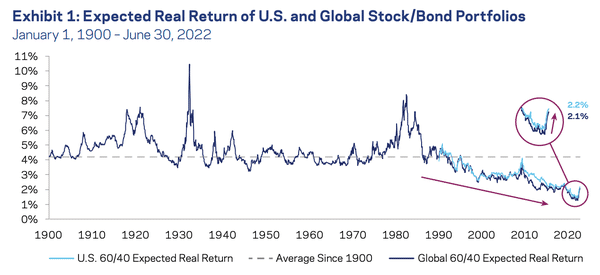
Stagflation
With most portfolios being quite vulnerable to the ill returns associated with economic stagflation & Fed tightening periods plus high valuations, the firm conducted a study to determine which asset classes could offer resilient returns in such an environment.
Unsurprisingly, commodities and U.S. Treasury Inflation-Protected Securities (TIPS) score the best, though they also found that long/short momentum strategies hold up quite well too.
So where then should we invest?
AQR highlights two specific momentum strategies that outperformed historically during bear markets and economic downturns.
Firstly are price-based trend following strategies that exploit recent performance. These are systematic, rules-based strategies that bet on the continued momentum of securities that have been rising the most or falling the most over a recent time period.
Another trend strategy they emphasize is based on what they call “macro momentum.”
Essentially, the strategy bets on assets in countries where fundamental economic trends are improving, while taking short positions (betting against) assets in places where economic indicators are deteriorating.
What to know
AQR’s biggest takeaway to share is actually quite simple though, as they say, “just diversify.” Building on this, “investors should not seek perfection — the most important thing is to take a decisive step towards investments that are exposed to fundamentally different risks from the dominant risks in (their) portfolio.”
Different types of risks will open you up to different patterns of returns over time.
Whether in large cap stocks vs small caps, growth vs value, stocks vs bonds, private markets vs public markets, U.S. equities vs global equities, investment grade corporate bonds vs high yield corporate bonds, etc.
The important thing when constructing portfolios is to be mindful of what each strategy and asset class offer, in terms of which market and economic periods they outperform during, and what drives their underlying risks.
Bonus chart
As a bonus, we wanted to throw in the below chart. It uses a range of historical valuation techniques to compare how “cheap” value stocks are relative to growth stocks globally.
While value stocks are less cheap than in, say, 2020, they’re still about as cheap (comparatively) as they were during the early 2000s tech bubble. Do with that as you will.
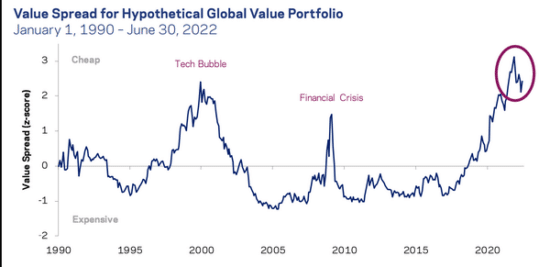
Wrapping up
AQR is not optimistic about traditional portfolios performing well over the rest of this year and over following periods, and they employ a number of fairly sophisticated strategies to tweak portfolios for a set-up that’s historically been quite unfavorable to most common financial assets.
For the ambitious investor, price trend and macro momentum strategies are worth investigating further, while TIPS and commodities also offer diversification benefits during stagflationary periods.
Based on relative cheapness, a bet on value stocks may be just as effective, if not more so, than the strategies outlined above.
There are many ways to find success in investing, but it often boils down to your goals, appetite for risk, and diversification.
Let us know — What’s your outlook for the rest of the year?
How’re you investing for stagflation and what opportunities do you see out there?
To read AQR’s full outlook and research, you can find it here.
And by the way, we’re hoping to get to know you better. If you haven’t filled out our reader survey yet, please do so!
ONE MORE THING
💍 Wedding advice for Patrick — I’m getting married next month, and I’ve been scratching my head as to what to get my groomsmen. The budget is $100 or less per groomsmen. I’d like it to be unique, meaningful, and useful. Ideally, something they will use frequently.
Would love to hear thoughts from our readers on ideas 💡
Readers: Tell me — What’s the best groomsmen gift you’ve ever seen?
SEE YOU NEXT TIME!
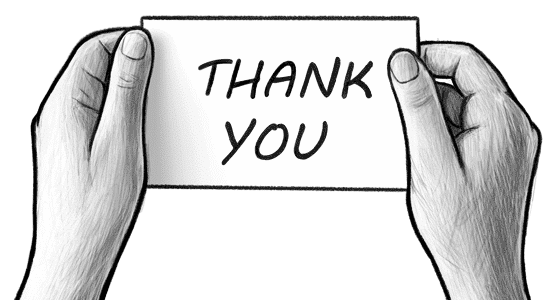
That’s it for today on We Study Markets!
See you later!
If you enjoyed the newsletter, keep an eye on your inbox for them on weekdays around 6pm EST, and if you have any feedback or topics you’d like us to discuss, simply respond to this email.





